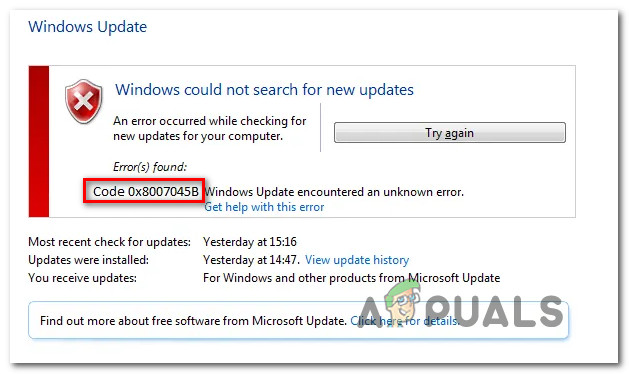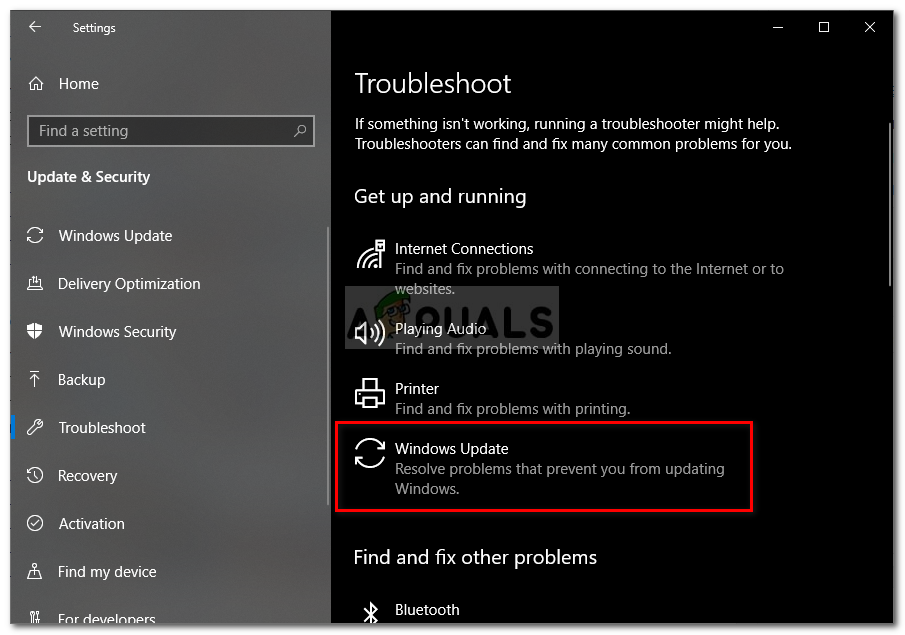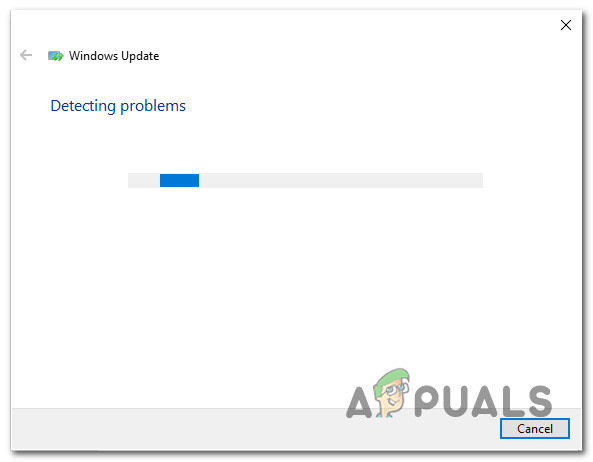How to Fix 0x8007045b Error on Windows?
Several Windows users have been reaching us with questions after encountering the error code 0x8007045B when trying to install certain updates or after a failed upgrade to Windows 10 from an older Windows version. Most affected users that are encountering this issue with updates are reporting that multiple updates fail with the same error code. As it turns out, the issue is not exclusive to a certain WIndows version since it’s confirmed to occur on Windows 7, Windows 8.1 and Windows 10.

What is causing the error code 0x8007045B on Windows?
We investigated this particular issue by looking at various user reports and the repair strategies that are most commonly used to treat this problem. As it turns out, several different scenarios will trigger this error message. Here’s a shortlist with potential culprits:
- System File Corruption – One of the most common culprits that will cause this issue is system file corruption. This can have multiple causes, but most likely ones are manual user intervention or after an AV suite has quarantined some items. If this scenario is applicable, you will be able to resolve the issue either by repairing the corrupted instances via DISM and SFC or by performing a repair install.
- WU glitch – Under certain circumstances, this issue can occur due to a glitch that is effectively stopping WUs ability to download and install updates. In this case, the most viable fixes are to either use Windows Update troubleshooter to resolve the issue automatically or to reset all WU components manually via an elevated CMD window.
- 3rd party interference – As it turns out, there are certain overprotective 3rd party AV suites with the potential of blocking communications between your computer and the update server. If this scenario is applicable, the only viable fixes are to disable the real-time protection or to uninstall the 3rd party security suite completely.
If you’re currently looking for ways to resolve the error code 0x8007045B, this article will provide you with several different troubleshooting strategies. Down below, you’ll find a collection of methods that other users in a similar situation have successfully used to resolve the issue.
To remain as efficient as possible, we advise you to follow the methods below in the same order that we arranged them in (by efficiency and severity). Eventually, you should encounter a fix that will fix the issue regardless of the culprit that’s causing the issues.
Method 1: Running the Windows Update troubleshooter
Before you explore any other repair strategies, let’s make sure that your OS is not equipped to resolve the issue automatically. On Windows 10, a lot of affected users have reported that they managed to fix the problem simply by running the Windows Update troubleshooter.
Even though the built-in Troubleshooter has a history of being ineffective, it seems to be effective in a particular case. This built-in tool contains a wide selection of repair strategies that will be enforced automatically if a familiar issue is identified.
Here’s a quick guide on running the IWndows Update troubleshooter:
- Press Windows key + R to open up a Run dialog box. Next, type “ms-settings:troubleshoot” and press Enter to open up the Troubleshooting tab of the Settings app.

Opening the Troubleshooting tab of the Settings app via a Run box - Once you manage to get inside the Troubleshooting tab, move the cursor to the right section of the screen and navigate to the Getup and running section. Once you see that category, click on Windows Update, then click on Run the troubleshooter.

Running Windows Update Troubleshooter - Once you manage to start the utility, wait patiently until the scan is complete. This part will ultimately determine if any of the repair strategies included with this utility apply to your current situation.

Detecting problem with Windows Update - If a viable fix is recommended, you’ll see a window in which you can click on Apply this fix, to enforce the repair strategy. Depending on the type of fix that is applicable, you might need to follow a series of additional steps to enforce the repair strategies.

Apply this fix - After the fix is applied, restart your computer and repeat the action that was previously triggering the error once the next startup sequence is complete.
If the same error code 0x8007045B is still occurring, move down to the next method below.
Method 2: Perform a DISM or SFC scan
As it turns out, one of the most common culprits that will produce this error code is system file corruption. A large portion of affected users has reported that they managed to resolve the issue entirely after they used a couple of utilities capable of fixing instances of corrupted system files.
When it comes to this chore, all recent Windows versions have two effective built-in tools: SFC and DISM.
SFC (System File Corruption) is a built-in tool that scans and fixes system file corruption and logical errors by using a locally stored archive to replace bad files with healthy copies. This tool works best when having to restore Windows Resource Protection (WRP) files or when the issue is being caused by a logical error.
On the other hand, a DISM (Deployment Image Servicing and Management) scan will focus more on resolving issues associated with Windows Update and a few other associated components. But instead of using local data, DISM uses WU (Windows Update) to download healthy copies to replace file corruption.
As you can see, both utilities are focused on certain areas, so the best way to go about resolving the corruption on your computer is to deploy both. Here’s a quick guide on running both an SFC and a DISM scan from an elevated CMD window to resolve error code 0x8007045B:
- Press Windows key + R to open up a Run dialog box. After you do this, type “cmd” inside the text box and press Ctrl + Shift + Enter to open up the elevated Command Prompt. When you see the UAC (User Account Control) prompt, click Yes to grant administrative privileges.

Running Command Prompt as an administrator - Once you managed to get inside the elevated Command Prompt, type the following commands in order and press Enter after each command to scan and repair system file errors with DISM:
Dism.exe /online /cleanup-image /scanhealth Dism.exe /online /cleanup-image /restorehealth
Note: The first command is aimed at making the utility to scan your system for any inconsistencies, while the other one will start the repairing process. If no errors are found using the scan health command, there’s no point of running the second one. In this case, jump directly to step 3. Also, before running the second command, make sure that you have a stable internet connection since DISM needs it to download healthy copies.
- After the scan is finished, restart your computer and see if the issue is resolved at the next system startup by repeating the action that was previously causing the 0x8007045B error.
If the same issue is still occurring, move down to the next method below.
Method 3: Disable/Uninstall 3rd party antivirus (if applicable)
Another probable cause that will trigger the 0x8007045B error is an overprotective AV suite. If you’re encountering this problem while trying to install a pending Windows update and you’re using a 3rd party security suite, chances are the AV is blocking some communications with the update server.
McAfee, AVAST and Comodo are all known to cause this particular issue. Several users that were also affected by this problem have managed to resolve it by disabling the real-time protection or by uninstalling the security suite altogether.
At first, you should start by disabling the real-time protection and see if the issue is resolved automatically. But keep in mind that this operation will be different depending on the security suite that you’re using. However, in most cases, you will be able to do it directly from the tray-bar menu.

If you’re still encountering the 0x8007045B error, even after you disable the real-time protection, you might need to go for a more severe solution. Certain security suites (particularly ones with a built-in firewall) are programmed to maintain the security rules even when the real-time protection is disabled.
To avoid this, you’ll need to uninstall the program completely and ensure that you’re not leaving behind any leftover files. If you decide to do this, follow this article (here) to completely uninstall your 3rd party AV suite and remove any leftover files.
If this potential fix is not applicable or you’re still seeing the 0x8007045B error even after getting rid of your 3rd party av, move down to the next method below.
Method 4: Reset all Windows Services
If none of the methods above have allowed you to circumvent the 0x8007045B error, chances are you are dealing with a WU inconsistency that is effectively stopping your machines ability to update. Another clue that supports this scenario is if more than one updates are failing with this error code.
If this scenario applies to your situation, you will be able to resolve the issue by resetting all Windows components and dependencies involved in this process. We managed to identify a few user reports that were confirming this method as being successful in resolving the 0x8007045B error in their case.
Here’s a quick guide on addressing the issue by resetting all Windows update components manually from an elevated Command Prompt:
- Press Windows key + R to open up a Run dialog box. Next, type “cmd” inside the text box and press Ctrl + Shift + Enter to open up an elevated Command Prompt. When you’re prompted by the UAC (User Account Control), click Yes to grant admin access.

Running Command Prompt as an administrator - Inside the elevated Command prompt, type the following commands and press Enter:
net stop wuauserv net stop cryptSvc net stop bits net stop msiserver
Note: After you run these commands, you will have effectively stopped the Windows Update service, MSI Installer, Cryptographic service, and BITS services.
- After all, services are disabled, run the following commands in the same CMD window and press Enter after each command to rename the SoftwareDistribution and Catroot2 folders:
ren C:\Windows\SoftwareDistribution SoftwareDistribution.old ren C:\Windows\System32\catroot2 Catroot2.old
Note: These two folders are being actively used by WU to store the update files that are being used. By renaming them, you will force your OS to create new folders that are not being tainted by corruption.
- After you rename the two folders above, type the final commands below and press Enter after each one to restart the services that you previously disabled:
net start wuauserv net start cryptSvc net start bits net start msiserver
- Repeat the action that was previously triggering the 0x8007045B error and see if the issue is now resolved.
If you’re still encountering the same issue, move down to the final method below.
Method 5: Perform a repair install
If none of the methods above have allowed you to resolve the 0x8007045B error, chances are you’re dealing with an underlying system file corruption issue that cannot be fixed conventionally. In this case, the fix with the best likelihood of success is to reset every Windows component.
The easiest way of doing this is to perform a clean install. But keep in mind that going this route means that you’ll also lose personal data (apps, games, user preferences, personal media, etc.)
But there’s a better way – A repair install will allow you to reset all Windows components without losing all of your data. But on the downside, the procedure is more tedious than a clean install.
If you decide to perform a repair install (in-place repair), follow this article (here) for step-by-step instruction.





